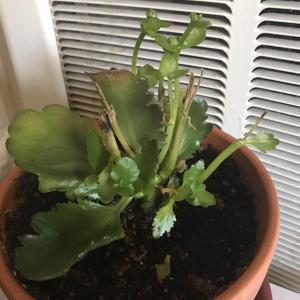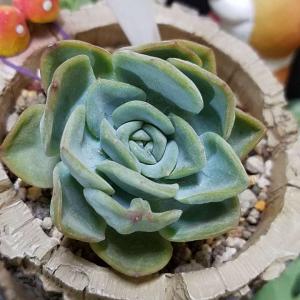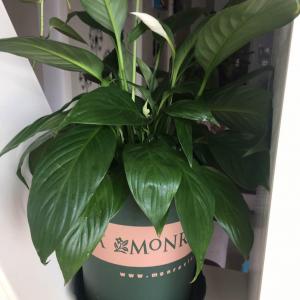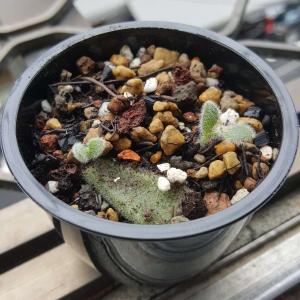文章
Dummer. ゛☀
2017年08月01日

Family - Ranunculaceae
Stems - To 80cm tall, glabrous, hollow, branching above, thick below but easily broken, herbaceous, from fibrous roots, erect.
Leaves - Basal and lowest leaves on long petioles. Petioles to -20cm long, glabrous. Blades 3-lobed, to 8cm long, 6cm broad, glabrous. Lobes somewhat divided again, with rounded teeth. Upper leaves alternate, becoming sessile near apex of stem, typically 3-lobed, glabrous, +10cm broad, 8-9cm long.
Inflorescence - Single flowers on short or long peduncles terminating branches, often appearing axillary. Peduncles glabrous or with few sparse hairs, subtended by simple to lobed foliaceous bracts (uppermost leaves).
Flowers - Petals 5, yellow, shiny above, dull below, free, 3-4mm long, 2mm broad, broadly oblong to elliptic, glabrous, with cup-like nectary at base. Stamens +/-20, from base of pistils. Filaments to 2mm long, glabrous, pale yellow. Anthers yellow, .3mm long. Pistils in a cylindric head expanding in fruit to +2cm long, 1cm in diameter. Achenes glabrous, tuberculate, to 1.3mm long, slightly compressed, with minute beak. Sepals 4, ovate, reflexed to spreading, falling early, free, 2.5-3mm long, 2mm broad, pubescent externally, cupped, yellow-green.
Flowering - May - August.
Habitat - Streambanks, muddy shores, ditches, moist ground.
Origin - Native to U.S. and Eurasia.
Other info. - This is one of the first plants I photographed in this state. The plant is a fast growing annual which produces a multitude of small yellow flowers. The fruits are quite large for the size of the flowers and make the plant easy to identify.
Our plant belong to variety sceleratus f. sceleratus. There is another form which is aquatic and not yet found in this state. This is form natans Gluck.
This species can be found along the Missouri, Mississippi, and a few other rivers.
The plant is somewhat toxic and can cause skin irritation to people allergic to it.
Stems - To 80cm tall, glabrous, hollow, branching above, thick below but easily broken, herbaceous, from fibrous roots, erect.
Leaves - Basal and lowest leaves on long petioles. Petioles to -20cm long, glabrous. Blades 3-lobed, to 8cm long, 6cm broad, glabrous. Lobes somewhat divided again, with rounded teeth. Upper leaves alternate, becoming sessile near apex of stem, typically 3-lobed, glabrous, +10cm broad, 8-9cm long.

Inflorescence - Single flowers on short or long peduncles terminating branches, often appearing axillary. Peduncles glabrous or with few sparse hairs, subtended by simple to lobed foliaceous bracts (uppermost leaves).

Flowers - Petals 5, yellow, shiny above, dull below, free, 3-4mm long, 2mm broad, broadly oblong to elliptic, glabrous, with cup-like nectary at base. Stamens +/-20, from base of pistils. Filaments to 2mm long, glabrous, pale yellow. Anthers yellow, .3mm long. Pistils in a cylindric head expanding in fruit to +2cm long, 1cm in diameter. Achenes glabrous, tuberculate, to 1.3mm long, slightly compressed, with minute beak. Sepals 4, ovate, reflexed to spreading, falling early, free, 2.5-3mm long, 2mm broad, pubescent externally, cupped, yellow-green.

Flowering - May - August.
Habitat - Streambanks, muddy shores, ditches, moist ground.
Origin - Native to U.S. and Eurasia.
Other info. - This is one of the first plants I photographed in this state. The plant is a fast growing annual which produces a multitude of small yellow flowers. The fruits are quite large for the size of the flowers and make the plant easy to identify.
Our plant belong to variety sceleratus f. sceleratus. There is another form which is aquatic and not yet found in this state. This is form natans Gluck.
This species can be found along the Missouri, Mississippi, and a few other rivers.
The plant is somewhat toxic and can cause skin irritation to people allergic to it.
0
0
文章
Dummer. ゛☀
2017年07月31日

Family - Berberidaceae
Stems - To -1.5m tall, woody, multiple from base, erect to prostrate, few branched, stoloniferous.
Leaves - Alternate, odd pinnate, evergreen. Leaflets typically 3-9, sessile, lance-ovate, serrate(teeth spinose), glabrous, dark green above, dull green to glaucous below, to +7cm long, +4cm broad, acute.

Inflorescence - Axillary and terminal racemes to 15cm long. Pedicels glabrous, elongating in fruit to +/-1.3cm long, subtended by one small bract to 4mm long.

Flowers - Petals 5-10, in 2-4 whorls, yellow, glabrous, 6-8mm long, 5mm broad, emarginate or obtuse. Stamens 6-10. Filaments to 3.5mm long glabrous. Ovary superior, green, glabrous. Stigma capitate. Style wanting. Sepals to 3mm long, 2mm broad, dense pubescent externally, with scarious margins, yellow.
Fruit - Globose to subglobose berry, blue-black, glaucous, to -1cm in diameter.

Flowering - May - July.
Habitat - Cultivated.
Origin - Native to U.S., cultivated in Missouri.
Other info. - This plant is native to the Northwestern U.S. where it grows in shaded forests. In Missouri the plant begins to bloom around May but in other states in can bloom throughout the year depending on the location. The berries are edible and are eaten by wildlife and humans alike. This is the state flower of Oregon. There are a few varieties in cultivation. Besides being eaten as a fruit,Mahonia has been used medicinally for centuries. The plant contains many alkaloids. Recently the plant has shown great promise in the treatment of psoriasis. Stay tuned.
Stems - To -1.5m tall, woody, multiple from base, erect to prostrate, few branched, stoloniferous.
Leaves - Alternate, odd pinnate, evergreen. Leaflets typically 3-9, sessile, lance-ovate, serrate(teeth spinose), glabrous, dark green above, dull green to glaucous below, to +7cm long, +4cm broad, acute.

Inflorescence - Axillary and terminal racemes to 15cm long. Pedicels glabrous, elongating in fruit to +/-1.3cm long, subtended by one small bract to 4mm long.

Flowers - Petals 5-10, in 2-4 whorls, yellow, glabrous, 6-8mm long, 5mm broad, emarginate or obtuse. Stamens 6-10. Filaments to 3.5mm long glabrous. Ovary superior, green, glabrous. Stigma capitate. Style wanting. Sepals to 3mm long, 2mm broad, dense pubescent externally, with scarious margins, yellow.
Fruit - Globose to subglobose berry, blue-black, glaucous, to -1cm in diameter.

Flowering - May - July.
Habitat - Cultivated.
Origin - Native to U.S., cultivated in Missouri.
Other info. - This plant is native to the Northwestern U.S. where it grows in shaded forests. In Missouri the plant begins to bloom around May but in other states in can bloom throughout the year depending on the location. The berries are edible and are eaten by wildlife and humans alike. This is the state flower of Oregon. There are a few varieties in cultivation. Besides being eaten as a fruit,Mahonia has been used medicinally for centuries. The plant contains many alkaloids. Recently the plant has shown great promise in the treatment of psoriasis. Stay tuned.
0
0
文章
Dummer. ゛☀
2017年07月31日

Family - Apiaceae
Stems - Flowering stems to +/-25cm tall, branching or simple, single or multiple from the base, fragrant, carinate, villous to hirsute, herbaceous, erect, from a thick bulbous taproot.
Leaves - Alternate, petiolate, 3-4 times pinnately divided. Petioles sheathing at base and often purplish at base. Entire leaf to -20cm long, 10-15cm broad, pilose. Primary divisions opposite, all other divisions alternate. Ultimate divisions linear to linear-oblanceolate, mucronate with a small whitish tip (use a lens to see), 3-4mm long, -1mm broad, with ciliate margins.

Inflorescence - Single terminal compound umbel per stem. Rays to 2cm long, densely pilose. Umbellets subtended by an involucre densely pilose bractlets. Bractlets linear-attenuate, to 4-5mm long, -1mm broad, +/-13 in number. Flowers +/-15 per umbellet. Pedicels to 2mm in flower, longer in fruit.

Flowers - Petals 5, yellow, glabrous, with an inflexed acuminate tip, 1.6-2mm long, .7mm broad. Stamens 5, spreading to erect. Filaments yellowish, +2mm long, glabrous. Anthers yellow, .6mm long. Styles 2, erect, 2.5mm long, curled, yellowish, glabrous, surrounded by an inflated nectary at base. Ovary inferior, green, glabrous, 1.5mm long, 2-locular. Sepals 5, whitish-green, acuminate, to .7mm long, glabrous. Fruits to 4mm long, 2.5mm broad, ellipsoid, pubescent, 2-seeded.

Flowering - April - May.
Habitat - Prairies, glades, rocky open ground.
Origin - Native to U.S.
Other info. - This little species is found in just a few counties in west-central Missouri. This species is easy to ID in the field. The fragrance and overall look of the plant (called gustalt by Doug Ladd), clearly place it in the Apiaceae. The big taproot is also a good indicator.
Stems - Flowering stems to +/-25cm tall, branching or simple, single or multiple from the base, fragrant, carinate, villous to hirsute, herbaceous, erect, from a thick bulbous taproot.
Leaves - Alternate, petiolate, 3-4 times pinnately divided. Petioles sheathing at base and often purplish at base. Entire leaf to -20cm long, 10-15cm broad, pilose. Primary divisions opposite, all other divisions alternate. Ultimate divisions linear to linear-oblanceolate, mucronate with a small whitish tip (use a lens to see), 3-4mm long, -1mm broad, with ciliate margins.

Inflorescence - Single terminal compound umbel per stem. Rays to 2cm long, densely pilose. Umbellets subtended by an involucre densely pilose bractlets. Bractlets linear-attenuate, to 4-5mm long, -1mm broad, +/-13 in number. Flowers +/-15 per umbellet. Pedicels to 2mm in flower, longer in fruit.

Flowers - Petals 5, yellow, glabrous, with an inflexed acuminate tip, 1.6-2mm long, .7mm broad. Stamens 5, spreading to erect. Filaments yellowish, +2mm long, glabrous. Anthers yellow, .6mm long. Styles 2, erect, 2.5mm long, curled, yellowish, glabrous, surrounded by an inflated nectary at base. Ovary inferior, green, glabrous, 1.5mm long, 2-locular. Sepals 5, whitish-green, acuminate, to .7mm long, glabrous. Fruits to 4mm long, 2.5mm broad, ellipsoid, pubescent, 2-seeded.

Flowering - April - May.
Habitat - Prairies, glades, rocky open ground.
Origin - Native to U.S.
Other info. - This little species is found in just a few counties in west-central Missouri. This species is easy to ID in the field. The fragrance and overall look of the plant (called gustalt by Doug Ladd), clearly place it in the Apiaceae. The big taproot is also a good indicator.
0
0
文章
Dummer. ゛☀
2017年07月31日

Family - Rosaceae
Stems - Multiple from base, spreading to ascending or erect, herbaceous, to +45cm long, villous, branching near apex.

Leaves - Alternate. Basal leaves toothed, typically unlobed but also 3 to 5-lobed, crenate-serrate, petiolate, to +25cm long. Lower cauline leaves pinnately divided, serrate, pubescent above, pubescent typically on veins below. Upper cauline leaves typically 3-lobed (lobes often divided further), serrate, ciliate-margined, glabrous to sparse pubescent above, pubescent on veins below, dull green above, silvery-green below. Stipules at base of petioles serrate, with same pubescence as leaf blade.

Inflorescence - Loose cymes terminating stems. Peduncles and pedicels with sparse villous pubescence mostly near base or glabrous.
Flowers - Petals yellow to yellow-orange, 5, to 3mm long, clawed, glabrous. Hypanthium campanulate, 2-3mm broad, 1.5mm tall (long), glabrous. Stamens +20, borne at edge of hypanthium, persistent in fruit. Filaments to 1mm long. Anthers yellow, .6mm in diameter. Sepals 5, acute to acuminate, 2mm long in flower, ciliate-margined, sharply recurved, persisting and elongating below fruit. Ovary stalked. Stalk elongating in fruit. Achenes glandular pubescent, beaked with persistent styles and stigmas.

Flowering - April - June.
Habitat - Moist ground, thicket edges, waste ground.
Origin - Native to U.S.
Other info. - This is a common little plant which can bloom fairly early in the season. The growth habits can be variable from erect to nearly prostrate. The flowers are very small, as you can see from the pics, and it is common for the petals to be fewer than 5. The achenes have a "hinged" barb which is the persistent style and stigma. The basal leaves are often missing or dying off by the time the plant is in heavy flower.
Stems - Multiple from base, spreading to ascending or erect, herbaceous, to +45cm long, villous, branching near apex.

Leaves - Alternate. Basal leaves toothed, typically unlobed but also 3 to 5-lobed, crenate-serrate, petiolate, to +25cm long. Lower cauline leaves pinnately divided, serrate, pubescent above, pubescent typically on veins below. Upper cauline leaves typically 3-lobed (lobes often divided further), serrate, ciliate-margined, glabrous to sparse pubescent above, pubescent on veins below, dull green above, silvery-green below. Stipules at base of petioles serrate, with same pubescence as leaf blade.

Inflorescence - Loose cymes terminating stems. Peduncles and pedicels with sparse villous pubescence mostly near base or glabrous.
Flowers - Petals yellow to yellow-orange, 5, to 3mm long, clawed, glabrous. Hypanthium campanulate, 2-3mm broad, 1.5mm tall (long), glabrous. Stamens +20, borne at edge of hypanthium, persistent in fruit. Filaments to 1mm long. Anthers yellow, .6mm in diameter. Sepals 5, acute to acuminate, 2mm long in flower, ciliate-margined, sharply recurved, persisting and elongating below fruit. Ovary stalked. Stalk elongating in fruit. Achenes glandular pubescent, beaked with persistent styles and stigmas.

Flowering - April - June.
Habitat - Moist ground, thicket edges, waste ground.
Origin - Native to U.S.
Other info. - This is a common little plant which can bloom fairly early in the season. The growth habits can be variable from erect to nearly prostrate. The flowers are very small, as you can see from the pics, and it is common for the petals to be fewer than 5. The achenes have a "hinged" barb which is the persistent style and stigma. The basal leaves are often missing or dying off by the time the plant is in heavy flower.
0
0
文章
Dummer. ゛☀
2017年07月30日

Family - Fabaceae
Stems - To +40cm tall, from thick caudex, villous to glabrous and glaucous, herbaceous, branching divaricately or divergently.

Leaves - Alternate, palmately 3-lobed, sessile to short petiolate(the petiole winged), stipulate. Stipules to -4cm long, 2cm broad, lanceolate-attenuate, ciliate margined, pubescent to glabrous. Lobes of leaves to +6cm long, +1.5cm broad, oblanceolate to spatulate, pubescent to glabrous.

Inflorescence - Terminal-horizontally spreading raceme to +25cm long. Flowers secund to top of axis. Each flower subtended by a single, ovate-lanceolate, foliaceous bract. Pedicels to +2.5cm long, hirsute to glabrous.
Flowers - Corolla papilionaceous, yellow. Standard to -3cm broad, +2cm long. Stamens 10, free. Filaments to 2cm long, glabrous, greenish-white. Anthers orange-yellow, 2mm long. Ovary terete, dense antrorse pubescent, tapering at apex. Calyx tubular, bilabiate. Calyx tube to 6mm long, pubescent externally(sometimes very sparse), internally lanate at apex and glabrous at base. Upper lip of calyx single-lobed. Lobe with notch at apex, 5mm long. Lower lip 3-lobed. Lobes 4mm long, deltoid.

Flowering - April - June.
Habitat - Prairies, rocky open woods.
Origin - Native to U.S.
Other info. - This is a fairly low growing plant which is easily spotted in the late spring growing along roadside prairies and open woods. The yellow horizontal inflorescences are unmistakable.
Steyermark lists two varieties for the plant. Variety leucophaea has pubescent stems and leaves. Variety glabrescens Larisey has stems which are glabrous and often glaucous, and leaves which are glabrous but still have ciliate margins. Variety glabrescens is also found more in the eastern half of the state.
A synonym for the plant is B. bracteata Muhl. var glabrescens (Larisely) Isely
Stems - To +40cm tall, from thick caudex, villous to glabrous and glaucous, herbaceous, branching divaricately or divergently.

Leaves - Alternate, palmately 3-lobed, sessile to short petiolate(the petiole winged), stipulate. Stipules to -4cm long, 2cm broad, lanceolate-attenuate, ciliate margined, pubescent to glabrous. Lobes of leaves to +6cm long, +1.5cm broad, oblanceolate to spatulate, pubescent to glabrous.

Inflorescence - Terminal-horizontally spreading raceme to +25cm long. Flowers secund to top of axis. Each flower subtended by a single, ovate-lanceolate, foliaceous bract. Pedicels to +2.5cm long, hirsute to glabrous.
Flowers - Corolla papilionaceous, yellow. Standard to -3cm broad, +2cm long. Stamens 10, free. Filaments to 2cm long, glabrous, greenish-white. Anthers orange-yellow, 2mm long. Ovary terete, dense antrorse pubescent, tapering at apex. Calyx tubular, bilabiate. Calyx tube to 6mm long, pubescent externally(sometimes very sparse), internally lanate at apex and glabrous at base. Upper lip of calyx single-lobed. Lobe with notch at apex, 5mm long. Lower lip 3-lobed. Lobes 4mm long, deltoid.

Flowering - April - June.
Habitat - Prairies, rocky open woods.
Origin - Native to U.S.
Other info. - This is a fairly low growing plant which is easily spotted in the late spring growing along roadside prairies and open woods. The yellow horizontal inflorescences are unmistakable.
Steyermark lists two varieties for the plant. Variety leucophaea has pubescent stems and leaves. Variety glabrescens Larisey has stems which are glabrous and often glaucous, and leaves which are glabrous but still have ciliate margins. Variety glabrescens is also found more in the eastern half of the state.
A synonym for the plant is B. bracteata Muhl. var glabrescens (Larisely) Isely
0
0
文章
Dummer. ゛☀
2017年07月30日

Family - Asteraceae
Stems - To +60cm tall, erect, herbaceous, annual, from a taproot, typically single from the base and simple in the basal 1/2-2/3. Lower stem appearing woody, 3-5mm in diameter, grayish-brown. Stems in inflorescence divaricate, glabrous, green, angled or grooved.

Leaves - Mostly absent at anthesis. Leaves of the inflorescence linear, sessile, with punctate dots (use lens to see) and minute serrulate teeth on the leaf margins (use lens to see), +/-1mm broad, to 6cm long.
Inflorescence - Many small flower heads terminating each branch of the inflorescence. Stems spreading to +/-50cm broad at anthesis in a "mound" shape. Each flower head subtended by linear bracts giving way to the involucre.
Involucre - +/-2-3mm broad, 2-3mm tall, essentially biseriate. Lower series with green phyllaries. Phyllaries glabrous, linear-lanceolate, +/-2mm long, 1mm broad, acute. Inner series of phyllaries yellow-green (translucent at the base), glabrous, +3mm long, 1.5-1.8mm broad at the apex, acute, with the apical 1/4 spreading outward.

Ray flowers - +/-8 per flower head, spreading, pistillate and fertile. Ligule yellow, 3-4mm long, 2mm broad, elliptic-oblong, glabrous, with 2 impressed veins above (expressed below). Corolla tube 1-1.5mm long, whitish, glabrous. Style slightly exserted and bifurcate, whitish, .5-.6mm long, glabrous. Stigmas 1mm long, yellow, glabrous. Pappus absent or a minute, translucent crown.
Disk flowers - Disk +/-3mm broad, with +/-15 flowers. Flowers staminate. Corolla tube translucent-yellow, glabrous, 3mm long, 5-lobed. Lobes spreading, yellow, acute, +/-.5mm long, glabrous. Stamens 5, adnate at the base of the corolla tube. Filaments translucent, .7mm long. Anthers yellow, connivent around the undivided style, 1mm long, partially exserted. Style +2mm long, translucent in the basal 2/3, with the apical 1/3 pubescent and yellowish and exserted. Receptacle flat, naked but with ridges around the flower bases. Pappus a translucent awned crown. Awns equaling or exceeding the corolla. Crown (undivided portion) short, .3-.5mm long.

Flowering - July - October.
Habitat - Upland prairies, limestone and dolomite glades, bluff tops, riverbanks, fallow fields, disturbed sites, roadsides, railroads.
Origin - Native to U.S.
Other info. - This attractive little species can be found in the southwest corner of Missouri. Although it is not seen in the plant photo above, the plant nearly always grows from a single trunk-like base and then branches widely in the upper half (the whole plant being as wide or wider than tall). This species grows in profusion along roadsides in the Great Plains and is quite common there. It is far less abundant in Missouri.
A synonym is Gutierrezia dracunculoides (DC.) S.F. Blake
Stems - To +60cm tall, erect, herbaceous, annual, from a taproot, typically single from the base and simple in the basal 1/2-2/3. Lower stem appearing woody, 3-5mm in diameter, grayish-brown. Stems in inflorescence divaricate, glabrous, green, angled or grooved.

Leaves - Mostly absent at anthesis. Leaves of the inflorescence linear, sessile, with punctate dots (use lens to see) and minute serrulate teeth on the leaf margins (use lens to see), +/-1mm broad, to 6cm long.
Inflorescence - Many small flower heads terminating each branch of the inflorescence. Stems spreading to +/-50cm broad at anthesis in a "mound" shape. Each flower head subtended by linear bracts giving way to the involucre.
Involucre - +/-2-3mm broad, 2-3mm tall, essentially biseriate. Lower series with green phyllaries. Phyllaries glabrous, linear-lanceolate, +/-2mm long, 1mm broad, acute. Inner series of phyllaries yellow-green (translucent at the base), glabrous, +3mm long, 1.5-1.8mm broad at the apex, acute, with the apical 1/4 spreading outward.

Ray flowers - +/-8 per flower head, spreading, pistillate and fertile. Ligule yellow, 3-4mm long, 2mm broad, elliptic-oblong, glabrous, with 2 impressed veins above (expressed below). Corolla tube 1-1.5mm long, whitish, glabrous. Style slightly exserted and bifurcate, whitish, .5-.6mm long, glabrous. Stigmas 1mm long, yellow, glabrous. Pappus absent or a minute, translucent crown.
Disk flowers - Disk +/-3mm broad, with +/-15 flowers. Flowers staminate. Corolla tube translucent-yellow, glabrous, 3mm long, 5-lobed. Lobes spreading, yellow, acute, +/-.5mm long, glabrous. Stamens 5, adnate at the base of the corolla tube. Filaments translucent, .7mm long. Anthers yellow, connivent around the undivided style, 1mm long, partially exserted. Style +2mm long, translucent in the basal 2/3, with the apical 1/3 pubescent and yellowish and exserted. Receptacle flat, naked but with ridges around the flower bases. Pappus a translucent awned crown. Awns equaling or exceeding the corolla. Crown (undivided portion) short, .3-.5mm long.

Flowering - July - October.
Habitat - Upland prairies, limestone and dolomite glades, bluff tops, riverbanks, fallow fields, disturbed sites, roadsides, railroads.
Origin - Native to U.S.
Other info. - This attractive little species can be found in the southwest corner of Missouri. Although it is not seen in the plant photo above, the plant nearly always grows from a single trunk-like base and then branches widely in the upper half (the whole plant being as wide or wider than tall). This species grows in profusion along roadsides in the Great Plains and is quite common there. It is far less abundant in Missouri.
A synonym is Gutierrezia dracunculoides (DC.) S.F. Blake
0
0
求助
Potatoizaplant
2017年07月29日

I NEED HELP WITH MY KALANCHOE PLANT PLEASE! I bought this little guy a few months ago and it bloomed for my a few days after i bought it. It was fine until l 3 weeks later when i noticed the leaves shriveling up. It continued to lose it leaves and I pruned the flowers so it can focus all its energy on regaining its health. During the past few months I've repoted the plant, checking for root rot or any pest and i found nothing. Ive changed waterings, light, anything you can think off and it continues to loose it leaves. If you guys can help me save this plant, please comment any suggestions!


2
0
meriunkat:well all I know is that I water mine when the soil is dry which could be about every three days..and gradually exposed to sunlight
lizhufun:当金银花蕾生虫蛋如何处治
文章
Dummer. ゛☀
2017年07月29日

Family - Hippocastanaceae
Stems - Woody to 9m tall, with a single trunk or multiple trunks.
Leaves - Opposite, palmately compound, petiolate. Leaflets typically 5, but sometimes 6 or 7, 3-8cm wide, 15cm long, serrate, pubescent below, glabrous above, acuminate. Petiolules to 1cm long.
Inflorescence - Terminal panicle to 20cm long on new season growth. Axis of inflorescence densely pubescent with multicellular hairs. Pedicels pubescent, to 8mm long in flower.
Flowers - Petals 4, pale yellow to creamy whitish, clawed. Claws of upper petals to 3.5mm long, with dense tuft of villous pubescence at apex. Limb of upper petals +1.5cm long, 4mm broad at apex, with reddish spot near base of limb, pubescent. Lower petals with claw to 3.5mm long. Limb of lower petals +1cm long, 8-9mm broad, pubescent. Stamens 7, exserted. Filaments villous, to -2cm long, white. Anthers orange-red, 2mm long. Ovary 6mm long, dense villous at base but glabrous and reddish at apex. Calyx tube to 7mm long, 5mm in diameter, 5-lobed, yellow-green, pubescent. Lobes to 3mm long, obtuse, pubescent. Fruits globose, spiny, 2.5-6cm in diameter. Seeds 2 per fruit, +/-3cm in diameter, shiny, dark brown.
Flowering - April - May.
Habitat - Wooded slopes, ravines, thickets, open, rich woods, also cultivated.
Origin - Native to U.S.
Other info. - This species can be found throughout Missouri but is apparently absent from the extreme southeastern and northwestern corners of the state. The tree is easy to identify because of its palmately divided leaves (which are opposite) and its big inflorescences. The buds are easy to ID in winter also as they are quite large and the tree generally has a widely spreading growth habit. This species deserves to be cultivated more and it grows easily from seed. The fruits of the plant split into 3 parts and the seeds are actually edible. The seeds should be cooked first as they can be mildly toxic if eaten raw.
Stems - Woody to 9m tall, with a single trunk or multiple trunks.

Leaves - Opposite, palmately compound, petiolate. Leaflets typically 5, but sometimes 6 or 7, 3-8cm wide, 15cm long, serrate, pubescent below, glabrous above, acuminate. Petiolules to 1cm long.
Inflorescence - Terminal panicle to 20cm long on new season growth. Axis of inflorescence densely pubescent with multicellular hairs. Pedicels pubescent, to 8mm long in flower.

Flowers - Petals 4, pale yellow to creamy whitish, clawed. Claws of upper petals to 3.5mm long, with dense tuft of villous pubescence at apex. Limb of upper petals +1.5cm long, 4mm broad at apex, with reddish spot near base of limb, pubescent. Lower petals with claw to 3.5mm long. Limb of lower petals +1cm long, 8-9mm broad, pubescent. Stamens 7, exserted. Filaments villous, to -2cm long, white. Anthers orange-red, 2mm long. Ovary 6mm long, dense villous at base but glabrous and reddish at apex. Calyx tube to 7mm long, 5mm in diameter, 5-lobed, yellow-green, pubescent. Lobes to 3mm long, obtuse, pubescent. Fruits globose, spiny, 2.5-6cm in diameter. Seeds 2 per fruit, +/-3cm in diameter, shiny, dark brown.

Flowering - April - May.
Habitat - Wooded slopes, ravines, thickets, open, rich woods, also cultivated.
Origin - Native to U.S.
Other info. - This species can be found throughout Missouri but is apparently absent from the extreme southeastern and northwestern corners of the state. The tree is easy to identify because of its palmately divided leaves (which are opposite) and its big inflorescences. The buds are easy to ID in winter also as they are quite large and the tree generally has a widely spreading growth habit. This species deserves to be cultivated more and it grows easily from seed. The fruits of the plant split into 3 parts and the seeds are actually edible. The seeds should be cooked first as they can be mildly toxic if eaten raw.
0
0
文章
Dummer. ゛☀
2017年07月29日

Family - Commelinaceae
Stems - Single or multiple from the base, from thickened roots, to 30cm tall, erect, herbaceous, glabrous basally, puberulent at the apex, slightly zig-zag. Hairs of the stem with thickened pustulate bases, multicellular (of 2-3 cells).
Leaves - Alternate, sessile, sheathing at the base, with the blades narrower than their flattened and unfolded sheaths. Sheaths glabrous, with long pilose hairs on the margins. Leaf blades linear, grass-like, sparsely hairy, with long cilia on the margins basally, to +30cm long, to +/-1.5cm broad, entire, green above, silvery-green below with parallel venation.
Inflorescence - Terminal umbel of 2-many flowers. Flowers subtended by 1-2 foliaceous bracts. Bracts sessile, pubescent, broader and shorter than the leaves. Flowers opening a few at a time. Pedicels pinkish-green, +/-2.5cm long, densely spreading pubescent with short and long multicellular hairs.
Flowers - Petals 3, purple to pinkish-red, broadly ovate, to 2cm long and broad, glabrous, spreading. Stamens 6, erect. Filaments +/-6mm long, purple, glabrous in the apical 1/2, densely pubescent with long, purple, multicellular hairs in the basal 1/2. Anthers yellow, 2-lobed, +2.5mm broad. Ovary light green, glabrous, 2mm long, +/-1.3mm broad. Style +3mm long, glabrous, purplish. Sepals 3, to 1.5cm long, +/-7mm broad, elliptic, entire, slightly inflated, acute, densely pubescent externally, glabrous internally, distinct.
Flowering - April - June.
Habitat - Mesic to dry upland forests, shaded ledges of bluffs, open rocky woods, glade edges, railroads.
Origin - Native to U.S.
Other info. - This striking species can be found mainly in the eastern half of Missouri in counties that border the Missouri and Mississippi rivers. The plant can be identified by its small size, pubescent sepals, and narrow leaves. This species seems to prefer acidic soils but would do well in cultivation and makes an attractive garden specimen.
Stems - Single or multiple from the base, from thickened roots, to 30cm tall, erect, herbaceous, glabrous basally, puberulent at the apex, slightly zig-zag. Hairs of the stem with thickened pustulate bases, multicellular (of 2-3 cells).
Leaves - Alternate, sessile, sheathing at the base, with the blades narrower than their flattened and unfolded sheaths. Sheaths glabrous, with long pilose hairs on the margins. Leaf blades linear, grass-like, sparsely hairy, with long cilia on the margins basally, to +30cm long, to +/-1.5cm broad, entire, green above, silvery-green below with parallel venation.

Inflorescence - Terminal umbel of 2-many flowers. Flowers subtended by 1-2 foliaceous bracts. Bracts sessile, pubescent, broader and shorter than the leaves. Flowers opening a few at a time. Pedicels pinkish-green, +/-2.5cm long, densely spreading pubescent with short and long multicellular hairs.

Flowers - Petals 3, purple to pinkish-red, broadly ovate, to 2cm long and broad, glabrous, spreading. Stamens 6, erect. Filaments +/-6mm long, purple, glabrous in the apical 1/2, densely pubescent with long, purple, multicellular hairs in the basal 1/2. Anthers yellow, 2-lobed, +2.5mm broad. Ovary light green, glabrous, 2mm long, +/-1.3mm broad. Style +3mm long, glabrous, purplish. Sepals 3, to 1.5cm long, +/-7mm broad, elliptic, entire, slightly inflated, acute, densely pubescent externally, glabrous internally, distinct.

Flowering - April - June.
Habitat - Mesic to dry upland forests, shaded ledges of bluffs, open rocky woods, glade edges, railroads.
Origin - Native to U.S.
Other info. - This striking species can be found mainly in the eastern half of Missouri in counties that border the Missouri and Mississippi rivers. The plant can be identified by its small size, pubescent sepals, and narrow leaves. This species seems to prefer acidic soils but would do well in cultivation and makes an attractive garden specimen.
1
0
文章
Dummer. ゛☀
2017年07月29日

Family - Liliaceae
Stems - Aerial stems to +15cm tall, erect, green, glabrous, angled, purplish near apex, from small bulb. Bulb +/-1cm in diameter, with fibrous roots.
Leaves - Basal, typically 2-3 per plant, folded longitudinally at base, entire, linear to narrowly oblong, to +/-20cm long, 1.5cm broad.
Inflorescence - Few flowered raceme terminating the aerial stem, sometimes just single-flowered. Pedicels purple, 6-9mm long, glabrous, subtended by small scales. Scales light purple, succulent, to 1.5mm long.
Flowers - Tepals 6, 1.5-1.7cm long, 5-6mm broad, blue, glabrous, oblong to narrowly ovate, entire, with a single blue midvein. Stamens 6, adnate to the base of the tepals. Filaments white, erect, 8mm long, glabrous, compressed at base. Anthers blue, 2.1mm long. Style 6mm long, purple, glabrous. Ovary green, superior, 4mm long, 3-angled, 3-locular. Placentation axile. Seeds (ovules) many.
Flowering - March - April.
Habitat - Mesic bottoms, moist slopes, roadsides, fields.
Origin - Native to Russia.
Other info. - This attractive little garden species has escaped to a few counties in Missouri but is widely cultivated. Where escaped it can be quite aggressive and locally abundant.
The typical flower color is blue but colors vary depending on the cultivar. So far, only the blue flowered plants are found wild in Missouri. Like most plants in the genus, this species is toxic.
Stems - Aerial stems to +15cm tall, erect, green, glabrous, angled, purplish near apex, from small bulb. Bulb +/-1cm in diameter, with fibrous roots.
Leaves - Basal, typically 2-3 per plant, folded longitudinally at base, entire, linear to narrowly oblong, to +/-20cm long, 1.5cm broad.

Inflorescence - Few flowered raceme terminating the aerial stem, sometimes just single-flowered. Pedicels purple, 6-9mm long, glabrous, subtended by small scales. Scales light purple, succulent, to 1.5mm long.
Flowers - Tepals 6, 1.5-1.7cm long, 5-6mm broad, blue, glabrous, oblong to narrowly ovate, entire, with a single blue midvein. Stamens 6, adnate to the base of the tepals. Filaments white, erect, 8mm long, glabrous, compressed at base. Anthers blue, 2.1mm long. Style 6mm long, purple, glabrous. Ovary green, superior, 4mm long, 3-angled, 3-locular. Placentation axile. Seeds (ovules) many.

Flowering - March - April.
Habitat - Mesic bottoms, moist slopes, roadsides, fields.
Origin - Native to Russia.
Other info. - This attractive little garden species has escaped to a few counties in Missouri but is widely cultivated. Where escaped it can be quite aggressive and locally abundant.

The typical flower color is blue but colors vary depending on the cultivar. So far, only the blue flowered plants are found wild in Missouri. Like most plants in the genus, this species is toxic.
0
0
文章
Dummer. ゛☀
2017年07月29日

Family - Passifloraceae
Stems - Vinning, glabrous to minutely pubescent, herbaceous. Tendrils present.
Leaves - Alternate, 3-lobed, serrulate, petiolate, to +15cm long, +13cm wide, glabrous. Petioles with two glands near base of leaf blade.
Inflorescence - Single pedicillate flowers from leaf axils.
Flowers - Very interesting. This flower exhibits a corona which is a structure of appendages situated between the corolla and stamens. In the picture the corona is the ringlike structure of purple and white appendages above the petals and sepals. Flower is typically 6-7cm broad. Petals 5, sepals 5, purplish to whitish, similar, alternating. Styles 3. Stamens typically 5. Sepals 5, greenish-white, with a terminal appendage.
Fruit - Fleshy, ovoid to globose, green at first, yellowish-red at maturity.
Flowering - June - September.
Habitat - Thickets, disturbed sites, waste ground, roadsides, railroads. Also cultivated.
Origin - Native to U.S.
Other info. - This plant and its relatives have an edible fruit often seen in drinks as "Passion fruit". Some folks like it, some don't. In his particular species the mucilage around the seeds of the fruit is quite sweet and delicious.
The genus name comes from the story of Jesus in Christianity, the "Passion". The flower parts are telling of the story. The petals and sepals are representative of the disciples of Jesus, except for Judas and Peter. The stamens, numbering 5, represent the wounds of Jesus. The stigmas, because of their shape, represent the nails used in the crucifixion. The corona represents the crown of thorns.
Stems - Vinning, glabrous to minutely pubescent, herbaceous. Tendrils present.
Leaves - Alternate, 3-lobed, serrulate, petiolate, to +15cm long, +13cm wide, glabrous. Petioles with two glands near base of leaf blade.

Inflorescence - Single pedicillate flowers from leaf axils.
Flowers - Very interesting. This flower exhibits a corona which is a structure of appendages situated between the corolla and stamens. In the picture the corona is the ringlike structure of purple and white appendages above the petals and sepals. Flower is typically 6-7cm broad. Petals 5, sepals 5, purplish to whitish, similar, alternating. Styles 3. Stamens typically 5. Sepals 5, greenish-white, with a terminal appendage.

Fruit - Fleshy, ovoid to globose, green at first, yellowish-red at maturity.
Flowering - June - September.
Habitat - Thickets, disturbed sites, waste ground, roadsides, railroads. Also cultivated.
Origin - Native to U.S.
Other info. - This plant and its relatives have an edible fruit often seen in drinks as "Passion fruit". Some folks like it, some don't. In his particular species the mucilage around the seeds of the fruit is quite sweet and delicious.

The genus name comes from the story of Jesus in Christianity, the "Passion". The flower parts are telling of the story. The petals and sepals are representative of the disciples of Jesus, except for Judas and Peter. The stamens, numbering 5, represent the wounds of Jesus. The stigmas, because of their shape, represent the nails used in the crucifixion. The corona represents the crown of thorns.
0
0












